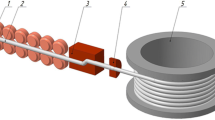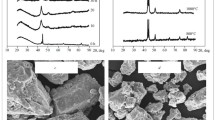Conclusions
-
1.
A study was made of the pressing behavior of molybdenum fibers in work-hardened and annealed conditions, as a result of which it was established that the residual porosity of compacts as a function of compaction pressure is described by an exponential relationship.
-
2.
The apparent density of fibers was found to rise linearly with increase in their diameter and to fall with increase in their length.
Similar content being viewed by others
Literature cited
M. Yu. Bal'shin, Metal Powder Science [in Russian], Metallurgizdat, Moscow (1948).
M. Yu. Bal'shin, Powder Metallurgy [in Russian], Mashgiz, Moscow (1948).
N. F. Kunin and B. D. Yurchenko, Poroshkovaya Met.,3, No. 6 (1963).
N. F. Kunin and B. D. Yurchenko, Poroshkovaya Met.,3, No. 2 (1964).
G. M. Zhdanovich, Theory of Pressing of Metal Powders [in Russian], Metallurgiya, Moscow (1969).
Author information
Authors and Affiliations
Additional information
Translated from Poroshkovaya Metallurgiya, No. 6 (114), pp. 10–14, June, 1972.
Rights and permissions
About this article
Cite this article
Pochkai, G.N., Rybal'chenko, M.K. & Samsonov, G.V. Some pressing characteristics of molybdenum wire (fibers). Powder Metall Met Ceram 11, 437–440 (1972). https://doi.org/10.1007/BF00797916
Received:
Issue Date:
DOI: https://doi.org/10.1007/BF00797916




